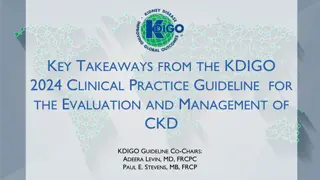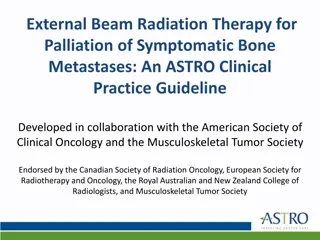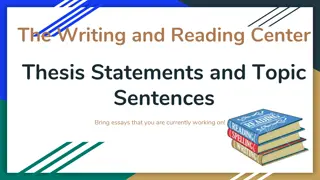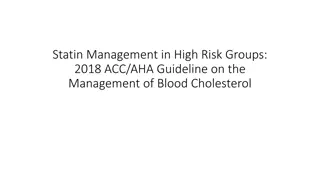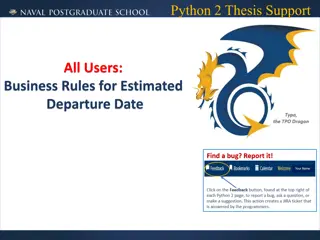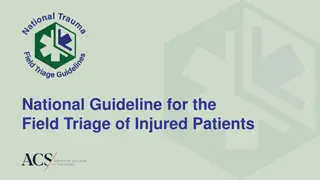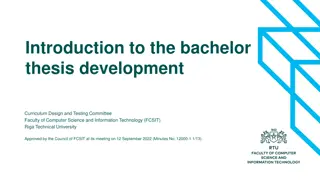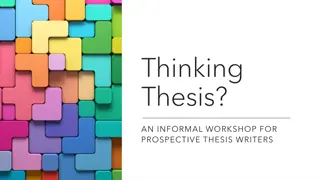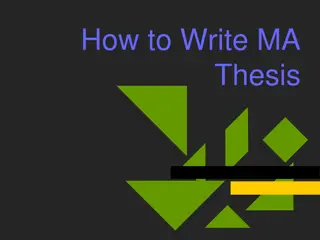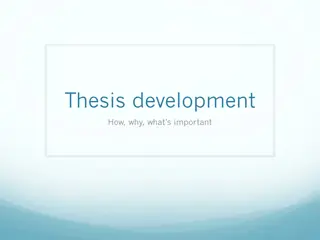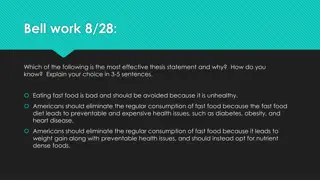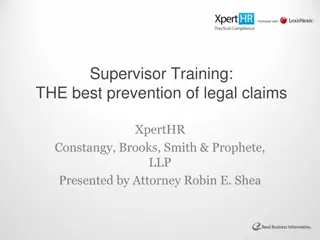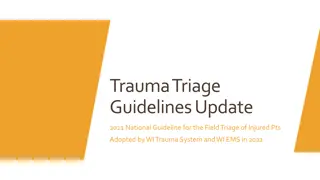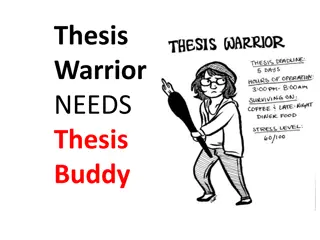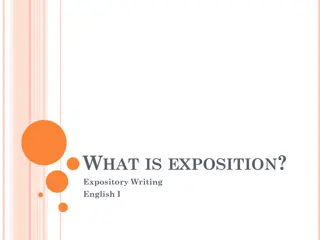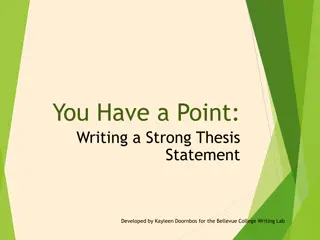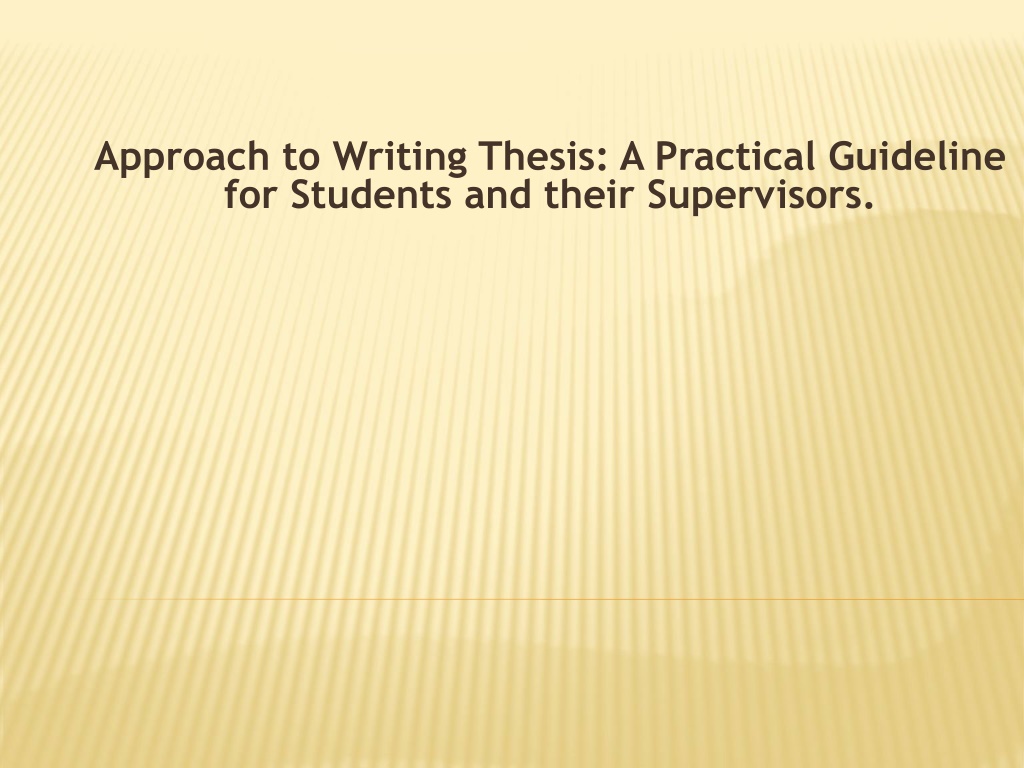
Practical Guidelines for Researching and Writing Thesis
Learn about four different approaches to conducting research and writing a thesis, including the regular approach, replication approach, case study approach, and critical review approach. Understand the importance of problem statements, research objectives, and contributions in each approach to enhance your academic writing skills.
Download Presentation

Please find below an Image/Link to download the presentation.
The content on the website is provided AS IS for your information and personal use only. It may not be sold, licensed, or shared on other websites without obtaining consent from the author. If you encounter any issues during the download, it is possible that the publisher has removed the file from their server.
You are allowed to download the files provided on this website for personal or commercial use, subject to the condition that they are used lawfully. All files are the property of their respective owners.
The content on the website is provided AS IS for your information and personal use only. It may not be sold, licensed, or shared on other websites without obtaining consent from the author.
E N D
Presentation Transcript
Approach to Writing Thesis: A Practical Guideline for Students and their Supervisors.
Four Approaches to Doing Research and Writing Thesis 1. The regular approach 2. The replication approach 3. Case study approach 4. Critical Review approach
THE REGULAR APPROACH Background Background: Why is it Important? For Each issue Arguments is needed for each issue Problem Statement Problem Statement: (1) Theoretical or (2) Phenomenon What is wrong with (1) or with (2) Arguments and discussion Research Objective Research Objective: gap should be solved and how to solve? Contribution Contribution: should be clear based on the proposed solution
REPLICATION APPROACH Background: why replication? Arguments needed Problem Statement: what is wrong with new setting given the issue in the replicated Research Objective: solving the solution given in the replicated Contribution: proposed solution based on the issue in the replicated Discuss the findings compared to the replicated
CASE STUDY APPROACH Factual Summary Problem Statements Analysis of problems Solutions Recommended Solution Implementation
FACTUAL SUMMARY Comprehend case situation Speed read case Read case carefully, taking notes, underlining Write the important facts to a problem(s) For that purpose avoid to: Copy and paste the case material Paraphrasing is required facts and data data leading
PROBLEM STATEMENTS The case analysis is leading toward definition of a problem (s) Problem? a situation where effective action can be planned to improve the situation of the organization Indicates both areas needing corrective action and areas of opportunities for new actions Some steps: identify problem areas, list problem area from notes and a rereading of case use evidence to diagnose each problem area in turn
IDENTIFYING PROBLEM AREAS Identify problem areas situations exhibiting unusual behavior, conflicts, change, stagnation The word problem is associated with the difference beween existing situation and some desired situation . .. The process of problem finding is the process of finding differences Thus, the problem-finder must comprehend both the existing state and identify te attainable state
THE MODELING APPROACH TO PROBLEM IDENTIFICATION Historical model Model from the environment Planning model Personal model
PROBLEM STATEMENTS Based on the identification of problem area, problem(s) should be stated Major ad Minor problems are OK State problem explicitly
ANALYSIS OF PROBLEMS The objective of the analysis is to make sure the problems stated are `logical Detailed data and facts are required The analysis can also lead to the solutions
SOLUTIONS Sources of Solutions are concepts and experiences List the possible solutions with pros and cons points Any possible solutions should be explained clearly first before listing the pros and cons
RECOMMENDED SOLUTIONS Given the possible solutions, recommend the most possible solution Argumentations are required
Implementation List efforts to be done to make the recommended solution workable Contingency plan if the recommended solution is not workable, what you are goingto?
CRITICAL REVIEW APPROACH Introduction Introduction Discussion Discussion Conclusion Conclusion References References Attachment Attachment
INTRODUCTION INTRODUCTION Summary of Article Problem: Theoretical concept Research methodology Research findings
DISCUSSION DISCUSSION Review of Theoretical Review of Theoretical Concept Review of Research Review of Research Methodology Review of Research Findings Review of Research Findings Concept Methodology
CONCLUSION CONCLUSION: This section contain conclusion you draw from based on your evaluation of main article you are commenting in terms of theoretical concept, methodological consideration, and research finding
MODEL OF DOCTORAL RESEARCH MODEL OF DOCTORAL RESEARCH
DOCTORAL STUDY IS JOURNEY TO GET DOCTORAL DEGRE THE END OF RESEARCH STUDY
WHY DO DOCTORAL RESEARCHERS GET ASKED WHY DO DOCTORAL RESEARCHERS GET ASKED TO READ SO TO READ SO MUCH? MUCH? (1) To map the field or fields relevant to the inquiry To map the field or fields relevant to the inquiry. This is likely to involve both showing something of the historical development of the field(s),discussing its empirical and theoretical bases and biases, as well as identifying major debates, key figures and seminal texts. (2) To establish which studies, ideas and/or methods are most pertinent To establish which studies, ideas and/or methods are most pertinent to the specific research being undertaken. No project starts from scratch new research both uses and builds on existing findings. These pre-made building blocks are acknowledged through scrupulous citation practices. (3) To To create the warrant create the warrant for the research for the research. This may involve identifying gaps, bringing together ideas and approaches which have previously remained separate and/or speaking to a particular difficulty, puzzle or debate within the field. Through these three processes, researchers are equipped to not only argue why their research is needed and important, but they also are able: (4) To identify the particular contribution To identify the particular contribution that their research will make. Work with literatures allows researchers to name the conversation(s) which they will enter into and to articulate the chunk of knowledge they are offering to the scholarly community.
PROCESS RESEARCH PROPOSAL SUBMIT THE FINAL RESEARCH DEFEND IMPORTAT ISSUE OF DOCTORAL RESEARCH IS CONTRIBUTION CONTRIBUTION NOT COMPLEXITY
WHAT IS A RESEARCH GAP? It's what makes your manuscript publishable It's missing element in the existing research literature It's the gap that you fill with your research approach
APPROCAH TO GETTING RESEARCH GAP Phenomena: Mixed previous empirical results (positive/negative; significant/insignificant) Conflicts in theoretical approach Conflict in empirical methods Arbitrage between literatures Complex ( Rausser and Small, 2000: limited previous results, conflicts, arbitrage) Your approach to resolve mixed results, conflict, or arbritrage
Background to the research In journal articles, the introduction has the four stages outlined (Swales 1984): establish the overall field, summarise previous research, indicate the research gap, and state the purpose of the article and outline it. in a PhD thesis, these stages are spread through the whole of chapter 1 and parts of chapter 2, rather than in section 1.1.

